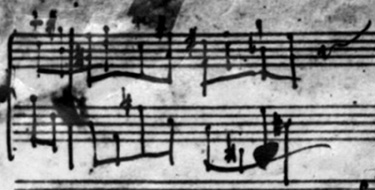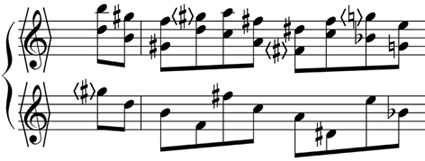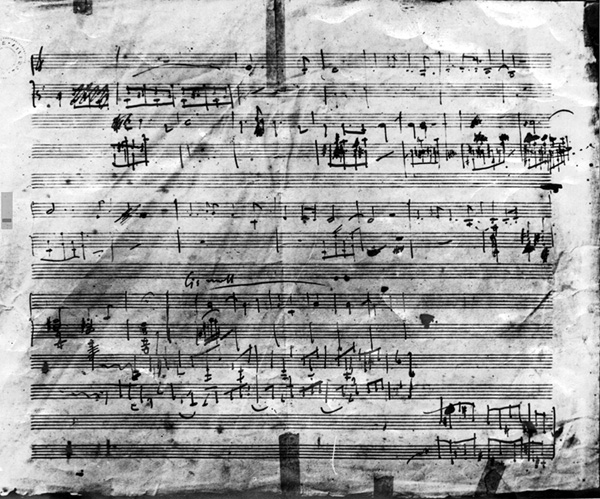| |
|
| |
|
ON preparing our critical edition of the first book of the Preludes, we have had to check the sketch of the second Prelude too, of course. This sketch (see above) is best visible on the well-deserving site OCVE (www.chopinonline.ac.uk/ocve/).
So, on p. 61 of the Thematisch-bibliographisches Werkverzeichnis, drawn up by Krystyna Kobylańska (München [G. Henle Verlag] 1979), we read: «Fourteen-line single leaf (22 x 28) with numerous damages. The text is on the verso (staves 1-10) along with three unidentified sketches (see section VI/11-13, p. 260). On the front you will find a sketch of the Mazurca Op. 41 No. 1 [...] and a second one of the Prelude No. 4 [...].”[1] Then, on page 260, the scholar specifies as follows:
“The sheet with the sketch of the Prelude Op. 28 No. 2 contains three other unidentified piano sketches:
(a) staves 9/10: six measures with an indication of the tone of C sharp minor; according to Bronarski [...] it recalls “certain phrases of Fantasy-Imprompt op. 66”;
(b) staves 11/12: four measures, which according to Bronarski recall the Tarantella op. 43;
(c) staves 13/14: two measures (second incomplete measure).”
As for the first sketch (a) in C sharp minor, we will not say anything here, as we will discuss it in our commentary on the Preludes.
Actually, the second sketch and the third one are the object of our brief note.
To decipher them, however, it is first of all necessary to turn up-side down the sheet. Kobylańska, in fact, affirming that in the third fragment (c) the "second measure [is] incomplete", shows to read these sketches up-side down. Since Chopin always writes the stem to the right of the notehead, this habit gives us the certainty about the orientation of the page. We add that these fragments do not present great problems of reading.
Let us start with the sketch (b):

And here is our reading. We to give a consistent harmony to the context have added the accidents between angled brackets:

In this sketch the only unclear aspect is given by the two horizontal squiggles after the fourth measure, which would seem to be two trills, but which—in our opinion—are a mnemonic graphic sign; that is to say, these two wavy lines would have reminded the composer of any development he had in mind—even if only sensed. [It is our duty to add, though late (June 2019), that Flamm—the editor of the last unsatisfactory edition of the Preludes, reviewed by us on this site—gives a different reading of the sketch. Actually, he copies the reading already given by Eigeldinger in his L'univers musical de Chopin (Paris [Fayard] 2000, p. 139), even if he quotes a previous article by the same Eigeldinger:

In fact, reading in F min. requires less accidentals. On the other hand, even if Flamm—i.e. Eigeldinger—could have used a better reproduction of these sketches, we do not agree with his reading of the last measure, which, besides, is almost indecipherable in our photocopy. Hence, even if the substance changes only a little or not at all, we accept Flamm's suggestion—already Eigeldinger's—and review the fragment as follows: 
According to Flamm the date (which actually refers only to Mazurca Op. 41 No. 1, see below) "allows us to assume that the cycle had not been completed already before departure to Mallorca." And about the sketch (b) and (a) he adds that "it seems reasonable to regard these sketches as discarded ideas for the Préludes in the corresponding keys, which therefore could not have been composed before Chopin's arrival in Mallorca." But such an assumption would perhaps be acceptable only if he could prove that these sketches were drafted in Mallorca, and that they are just preludes. On the contrary, being unlikely any relation with the date (see below), the clues suggest the opposite.] It does not seem to us that this idea recalls the Tarantella, as Bronarski believed: neither the tempo that the underlying musical thought seems to require nor the spirit of thought itself allows it. We think rather of an idea, which, not having been exploited, remained what it is, that is a simple draft. In other words, there is nothing to identify. In any case, we also want to emphasize that it is not the XXVIII Prelude! Shorter, but more interesting, the sketch (c): 
We read it as follows 
As you can see, there is not any second measure incomplete, because there is only one measure with anacrusis. Here too, as in sketch (b), follows a squiggle, shorter, but similar to those in sketch (b): its meaning is the same; and this wavy line, which is not a trill, confirms the meaning we hypothesise with regard to those in sketch (b). It seems undoubted that this is the sketch of the cadenza by sixths of the Etude Op. 10 No. 3. This identification allows us to make some considerations. It is quite natural that Chopin had brought to Mallorca, in addition to a good stock of music paper, all the material that would have served to complete the works already begun—and we refer above all to the Preludes—: that is, all the notes, all the working copies, in short, everything necessary. But, why should Chopin have to take with him a sheet on which he had sketched the cadenza of the cited and already published Etude? The most natural answer is that on that sheet he had written the almost definitive version of Prelude No. 2. This would confirm, too, that the project of composing a cycle of Preludes dated back many years, that is, at least from the early 30s. Chopin then used the other side of the sheet to sketch the Mazurka Op. 41 No. 1, dated November 28, 1839,[2] under which he also transcribed the almost definitive version of Prelude No. 4, which, in fact, presents very few corrections; from which we can deduce with some certainty that also the Prelude No. 4 had already been composed in Paris. NOTE [1]
It is not clear why the scholar attributed the sketch of the Prelude to the verso of the leaf and that of the Mazurka—which was written later—to the front. However, to avoid confusion, we will follow such attribution.
[2]
Müllemann in the online commentary of his edition (HN, München 2007) also reports this date to the Prelude No. 2, but it is a patent slip of the pen.
© Franco Luigi Viero | |
 | |
